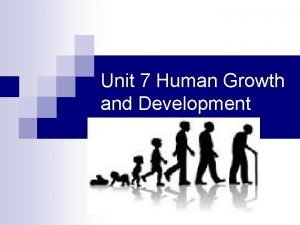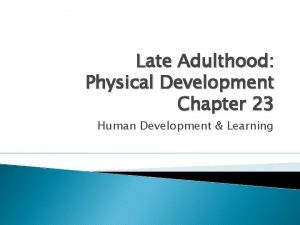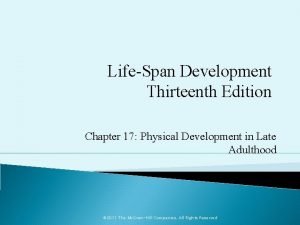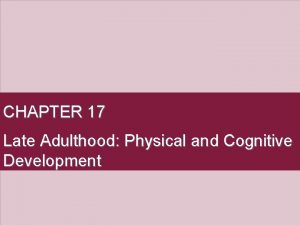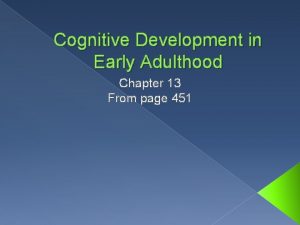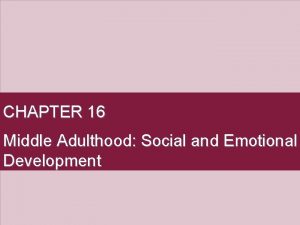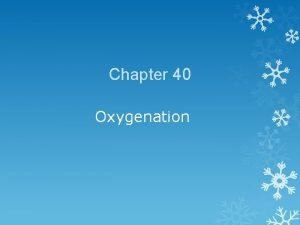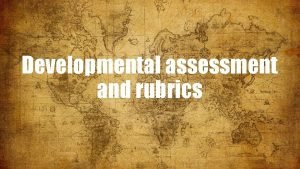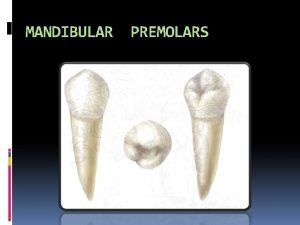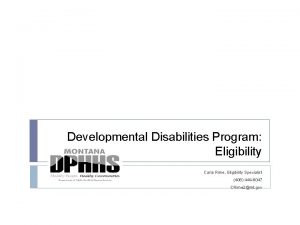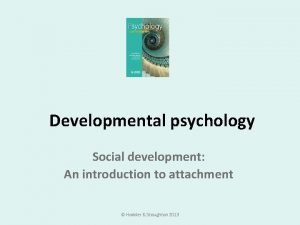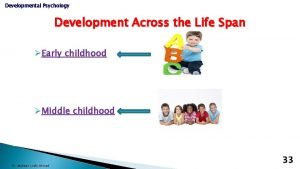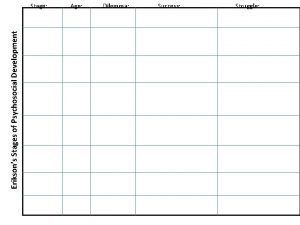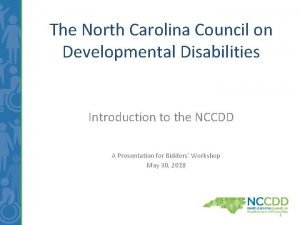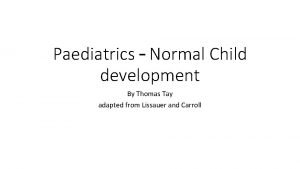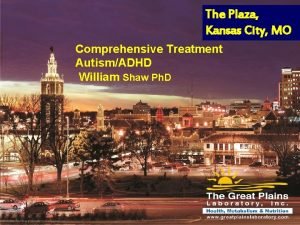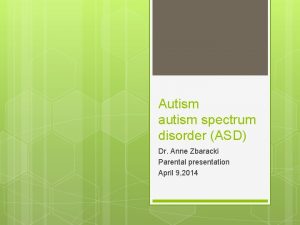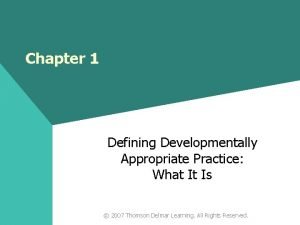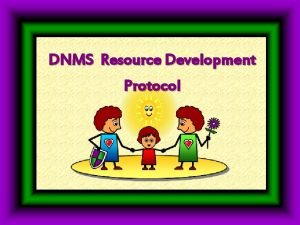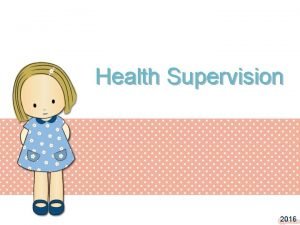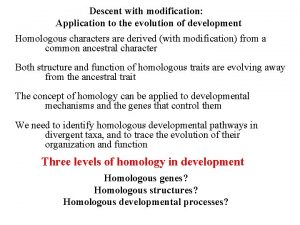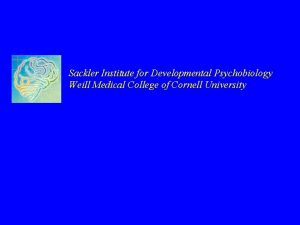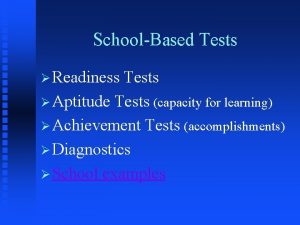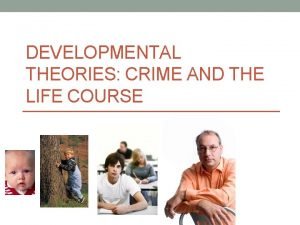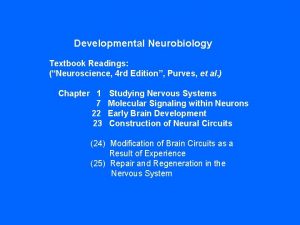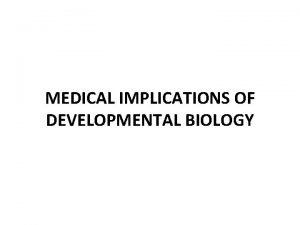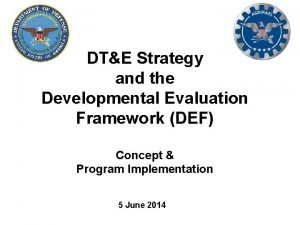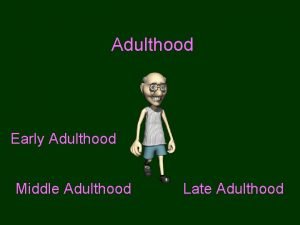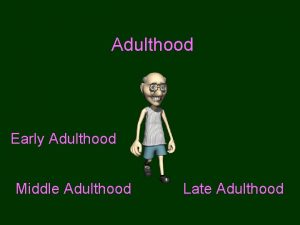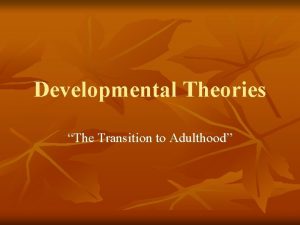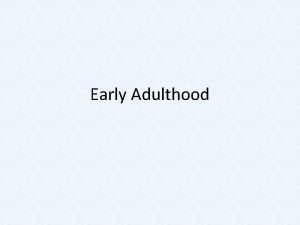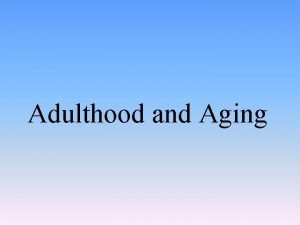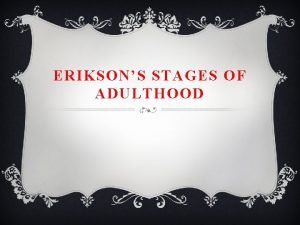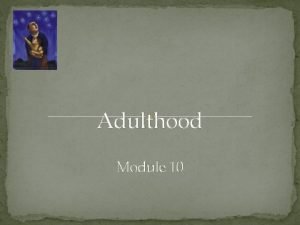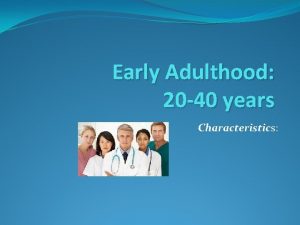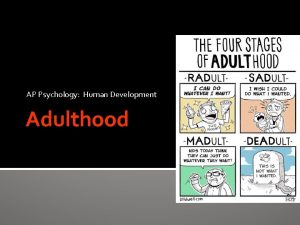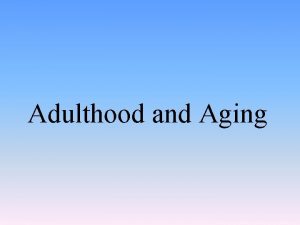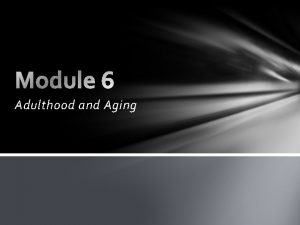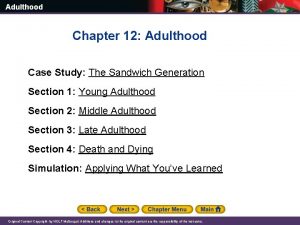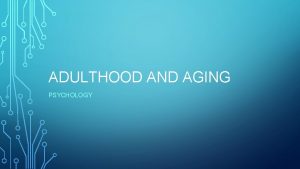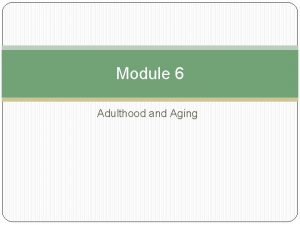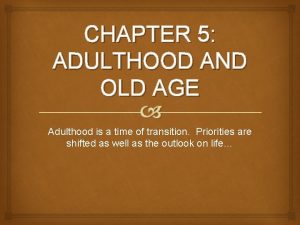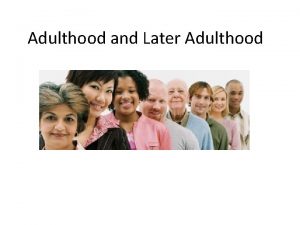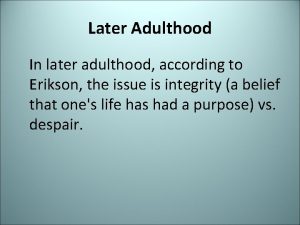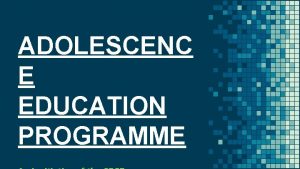DEVELOPMENTAL CHANGES IN 1 ADOLESCENC E 2 ADULTHOOD








































- Slides: 40

DEVELOPMENTAL CHANGES IN 1. ADOLESCENC E 2. ADULTHOOD 3. OLD AGE

Adolescence is a transitional age of physical and psychological human development generally occurring during the period from puberty to legal adulthood (age of majority). Adolescence is a period of time between childhood and adulthood.

Developmental Stages of Adolescence Early adolescence (9 -13 years) – characterized by a spurt of growth and the development of secondary sexual characteristics Mid adolescence (14 -15 years) – this stage is distinguished by the development of a separate identity from parents, of new relationships with peer groups and the opposite sex, and of experimentation. Late adolescence (16 -19 years) – At this stage, adolescents have fully developed physical characteristics (similar to adults), and have formed a distinct identity and have well-formed opinions and ideas.

Development Characteristics of adolescence Physical Experience onset of puberty, develop secondary sexcharacteristics. Grow rapidly, are often clumsy and uncoordinated. Become highly self-conscious, body image can affect self-image. Fluctuate between hyperactivity and lethargy. Need physical activity

Developmental Characteristics Cognitive- Intellectual: Develop ability to think abstractly, but many still think in literal terms. Develop critical thinking skills and become more selfaware, self-critical. Exhibit increased communication skills. Becomes argumentative and demonstrate an intense need to be “right”. Develop decision making skills and wants a voice in their choices. Show intense focus on a new interest but lack discipline to sustain it.

Developmental Characteristics Emotional They are unpredictable emotionally, are sensitive and prone to outbursts. Are vulnerable to emotional pleas and can be easily manipulated Exhibit an increasing capacity for empathy Experience increasing sexual feeling may engage in sexualbehaviour without realizing consequence

Developmental Characteristics Social – interpersonal Display a more developed social consciousness. Are more aware of relational ships and have a strong need to belong Exhibit desire for independence and autonomy Experience a shift in dependence on family to dependence on peers. Able to critically comparents with others. Seek deeper friendship based on shared interests loyalty Experience incresed interest in opposite sex, though may aftenfeel uncomfortable and awkward with the other sex.

Developmental Characteristics Moral Tend to be legalistic, focusing on “rules” and “fairness” Refrain moral belief of parents but begin to test rules ofchildhood Are influenced bt the values of peers Form a more personal conscience, seek moral criteria thatmake sense to them Exhibit a stronger sense of responsibility towards larger society

Common Problems of Adolescence The adolescent is a problem-individual. There are many problems around him and he needs help and guidance for their solution at every step. The following problems are the most significant in this stage.

Common Problems (Cont’d) Excessive Energy Adolescence is the stage of excessive energy. In-take of food is increased in this stage and general health is also improved. The result is excessive energy. The adolescent is restless. Various activities act as sublimation for the adolescents and they feel relieved.

Common Problems (Cont’d) Misunderstandings Concerning Sex The appearance of secondary sexual characteristics produce emotional upheaval in the adolescent. The first appearance of menstrual course or nocturnal emission bewilders and shocks the adolescent who is quite ignorant about it. Due to ignorance about sex, many promising personalities are doomed.

Common Problems (Cont’d) Aggressiveness or Withdrawal When an adolescent cannot adjust himself with the world, he grows to be aggressive or withdraws from the field and his personality is arrested. If the conflict is too serious, he regresses. Co curricular activities can go a long way in enabling the adolescent to adjust him with the world.

Common Problems (Cont’d) Rebellious Attitude The adolescents are no more children. Their craving for independence should be satisfied to some extent. They should be given someresponsibility. They turn to be very obedient if they are trusted. But things do not work so smoothly in ordinary schools and homes. Because their sense of independence and responsibility is seldom recognized, the result is rebellion against authority.

Common Problems (Cont’d) Emancipation It is the ambition for freedom from parental sovereign. The individual hates control of the parents. He seeksidentity to himself. Economic independence This is another problem of economic independence. Money from parents for personal expense is a major problem.

Common Problems (Cont’d) Emotional tension Emotional development is at maximum and unstable. Self respect and personal pride make the individual emotionally bad. He expects the things to be done as he aspires. Personal appearance This is a significant problem. The adolescent is much worried about the appearance with modern and latest life style at any cost.

Common Problems (Cont’d) Developmental Problems Over growth of hair or undergrowth of hair Over weight and underweight Facial deformities, pimples, etc. Abnormal growth of genitals and breasts. Psychological Problems Ignorance about many basic facts leads to psychological problems like Misconceptions about sexual feelings, sex related issues. Misconceptions about child birth, reproduction, coitus, menstrual cycles.

Common Problems (Cont’d) Psychological Problems Inferiority / Superiority complex about skin colour, beauty, mental-ability and IQ. Inexplicable perceptions about dress and fashion codes. Wrong and unrealistic ideologies about friendship and courtship. Attraction towards opposite sex. Unrealistic and illogical curiosity about sex and sex related issues. Exceptional vulnerability to suicide psychology.

Common Problems (End) Social Anticipated unemployment and insecurity due to unemployment. Unusually vulnerable and volatile relations with relatives Fear / imagination about married life, life partners. Educational Tensions of attending the classes, examinations and tests. Low IQ feeling. Fear about failure in examination/Fear about low score. Fear and concern about a future career. Misconceptions about teachers.

Role of a nurse/teacher Proper Physical Development is tackled by; 1. By organizing various types of physical exercises, sports and games. 2. By imparting a proper knowledge about physical and health education. 3. By organizing various types of extracurricular activities.

Role of a nurse/teacher Proper Mental Development should be according to the following lines: 1. It should be according to the ability and aptitude of the pupils. 2. They should study both arts and science subjects. 3. Excursions to various places may be organized. 4. Modern methods of teaching should be used to teach various subjects.

Role of a nurse/teacher 5. All the school teachers should try to impart him necessary guidance as and when required. 6. They should be entrusted with responsibility so as to develop a feeling of responsibility in them. 7. The teacher should keep in view that there are individual differences among students. Every child should be able to find out subjects of his choice.

Role of a nurse/teacher Proper Emotional Development 1. The teacher should try to sublimate the lower emotions of the child. 2. A healthy emotional atmosphere should be maintained in the school. 3. The teacher should try to avoid frustration among theadolescents. 4. The teacher should pay due regard to the personality of every child. 5. The adolescent should be imparted proper knowledge about sex. If this aspect is properly attended to it would lead to a better emotional development.

Role of a nurse/teacher Proper Social Development 1. He should have knowledge about social relations and he should know the art of group-living. Various group activities may be organized. 2. A right and rational attitude towards democracy should be developed in the school atmosphere. This would enable the child to develop his own philosophy.

ADULTHOOD Adults are individuals who have completed their growth and are ready to assume their status in society. An adult has grown to maturity. An adult is a person older than 19 years of age unless national law delimits an earlier age (WHO, 2016).

Stages in adulthood Early adult: 20 -40 years Middle adult: 41 -60 years Late adult: 61 and above

Physical and emotional maturity Characteristics of emotional maturity 1. Accepts constructive critism 2. opens to suggestion. 3. Learns from own and others experiences 4. Accepts responsibility for his own mistakes

Early adult Physical changes 1. Growth rate slows 2. Peak physical health is attained Emotional/social changes 1. Independence from family but stays close 2. Marriage and children

Middle adult Physical changes Gray hair, wrinkled skin, increase weight, balding Muscle tone and strength begin to reduce. Women: Menopause; 50 -55 years Men: Sex hormone & sperm start to decrease

Middle adult Emotional and social change Begins to accept mortality—Reflect on life Career and family transition to leadership role Care of aging parents.

Late adult Physical changes Aging: Decline in physiological functions Decreased physical activity and mobility Increased chronic disease and use of medications, Social/Emotional changes Loneliness, increased dependency Confronting death Isolation depression

OLD AGE Age is not merely a number. It represents a wealth of life experiences that shape whom we become. With medical advancements that prolong human life, old age has taken on a new meaning in societies. However, many aspects of the aging experience depend on social class, race, gender, and other social factors.

Phases of Aging The older adult population can be divided into three life-stage subgroups: The young-old (approximately 65– 74). The middle-old (ages 75– 84) The old-old (over age 85).

Changes in Old age Biological Changes Molecular and cellular changes are called primary aging. Aging due to controllable factors such as lack of physical exercise and poor diet is called secondary aging Physical markers of age; Skin becomes thinner, drier, and less elastic. Hair begins to thin and gray. Men prone to balding start losing hair. The difficulty or relative ease with which people adapt to these changes is dependent in part on the meaning given to aging by their particular culture.

Changes (Cont’d) Biological Changes Increase in functional impairments (disability) and chronic diseases. Reported health issues for the old age; Arthritis, Hypertension, Heart disease etc Decrease in male sexual performance

Changes (Cont’d) Social and Psychological Changes Retirement may pose a potential fear. When people many find new groups and explore new activities, but others may find it more difficult to adapt to new routines and loss of social roles, losing their sense of self-worth in the process In the final stage, old age, the challenge is to embrace integrity over despair. They may have to confront regrets, such as being disappointed in their children’s lives or perhaps their own.

Changes (Cont’d) Social and Psychological Changes For some, overcoming despair might entail remarriage after the death of a spouse. Many surviving women enjoyed a new sense of freedom, as many were living alone for the first time. For surviving men, there was a greater sense of having lost something.

Changes (Cont’d) Death and Dying: Kübler-Ross found that a person’s reaction to the prospect of dying as; Denial: This is characterized by not wanting to believe that he or she is dying, with common thoughts such as “I feel fine” or No, not me. It can’t be. ” This reaction ease anxiety and fearful thought. Anger: When loss of life is seen as unfair and unjust. The anger may be directed to self or others. Questions like ‘Why me? ’ comes to play.

Changes (Cont’d) Bargaining: Trying to negotiate with a higher power to postpone the inevitable by reforming or changing the way he or she lives. The person may try to barter with nurses, doctors, family or even God. Questions like ‘Okay, but please. . . ’ May bargain for a cure, extra time with family or less pain.

Depression: Allows for resignation as the situation begins to seem hopeless. Individual may grieve what he has lost. E. g Ability to walk or have independence, impending Acceptance: A person adjusts to the idea of death and reaches acceptance. At this point, the person can face death honestly, regarding it as a natural and inevitable part of life, and can make the most of their remaining time.

THANK YOU
 Social development in adulthood 19-45
Social development in adulthood 19-45 Forms of development
Forms of development Physical changes during early adulthood
Physical changes during early adulthood Filial maturity
Filial maturity Social changes in adulthood
Social changes in adulthood Stages of human growth and development pictures
Stages of human growth and development pictures Ros
Ros Physical changes in late adulthood
Physical changes in late adulthood Middle adulthood socioemotional development
Middle adulthood socioemotional development Physical changes in late adulthood
Physical changes in late adulthood Labouvie-vief pragmatic thought
Labouvie-vief pragmatic thought Social development in middle adulthood
Social development in middle adulthood Changes in latitudes, changes in attitudes meaning
Changes in latitudes, changes in attitudes meaning Chemical chnages
Chemical chnages Social development theory
Social development theory Factors affecting oxygenation and ventilation
Factors affecting oxygenation and ventilation Language quality
Language quality Lower first premolar anatomy
Lower first premolar anatomy Montana developmental disabilities program
Montana developmental disabilities program Attachment theory bowlby
Attachment theory bowlby Psychology
Psychology Erikson stages of development
Erikson stages of development Devonte is a graduate student in developmental psychology
Devonte is a graduate student in developmental psychology What is psychology
What is psychology North carolina council on developmental disabilities
North carolina council on developmental disabilities Royal college of paediatrics developmental milestones
Royal college of paediatrics developmental milestones Pdd disorder
Pdd disorder Developmental milestones بالعربي
Developmental milestones بالعربي Global developmental delay symptoms
Global developmental delay symptoms Developmentally appropriate programs are based on
Developmentally appropriate programs are based on Developmental needs meeting strategy
Developmental needs meeting strategy Health supervision
Health supervision Developmental homology
Developmental homology Unit 3 developmental psychology
Unit 3 developmental psychology Sackler institute for developmental psychobiology
Sackler institute for developmental psychobiology Metropolitan readiness test
Metropolitan readiness test Developmental theory criminology examples
Developmental theory criminology examples Developmental neuroscience textbook
Developmental neuroscience textbook Medical implications of developmental biology
Medical implications of developmental biology Research methods in developmental psychology
Research methods in developmental psychology Developmental evaluation framework
Developmental evaluation framework

